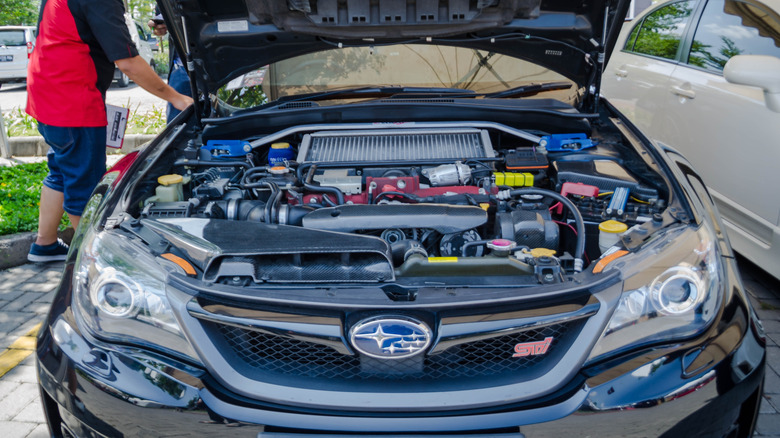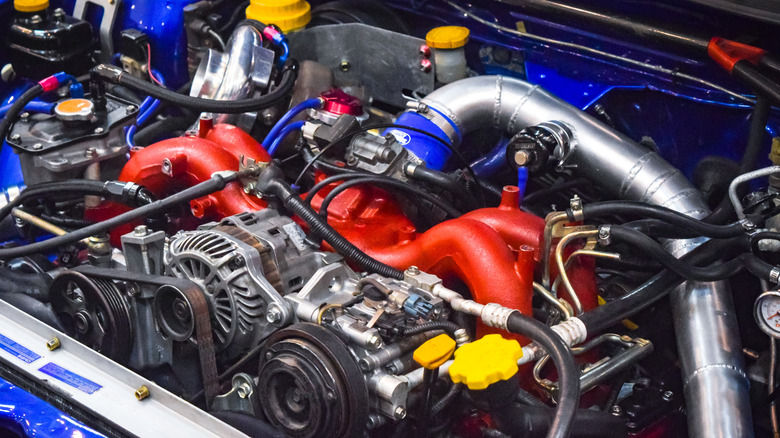When (And Why) Subaru Discontinued The EJ Engine
First introduced in 1989 with the Subaru Legacy and Subaru Liberty, the EJ series (and its EJ20 and EJ25 variants) became a fast favorite for the flat-four "boxer" layout. With a low center of gravity and a distinctive rumble to boot, those who know a thing or two about engines could plainly see that the EJ was everything a person could ask for in a boxer.
Over the decades to come, the EJ design would power everything from family sedans to legendary rally cars, like the Subaru WRX STI. This remarkable 30-year run is why the EJ engine's discontinuation came as such a shock. The discontinuation was twofold: In Japan, Subaru unveiled the (appropriately named) WRX STI EJ20 Final Edition at the 2019 Tokyo Motor Show to great fanfare. In the U.S., things were much more subtle: Subaru simply stopped putting EJs in its WRX STIs after the 2020 edition.
It wasn't any one thing that led to Subaru retiring the EJ, but more a combination of multiple factors. For one, the engine had changed very little over the years, which meant it struggled to meet modern efficiency and emissions standards. Beyond this, Subaru's company-wide focus had shifted toward next-generation platforms and engine technologies (including electrification, which just wasn't going to work with the EJ). Practically speaking: the EJ is a part of Subaru's past, not its future.
What does Subaru's future look like without the EJ?
The EJ engine might be done for (at least going forward), but that doesn't necessarily spell the end of Subaru's performance engines altogether. For example, the WRX has exchanged its former EJ engine for an FA. This gives it comparable performance specs to the EJ, just with modern efficiency and emissions standards to go with it. They're still relatively new, but FA-series engines have tremendous potential and are already some of the most reliable Subaru engines ever made.
That said, many EJ enthusiasts can't help but notice that the FA series lacks the same rumble that defined its predecessor. That makes for a pretty noticeable shift in the driving experience, something that Subaru boxer engines are known and loved for. Some viewed it as a controversial move — that's for sure. Even so, Subaru is expected to continue to prioritize efficiency and emissions standards over a nostalgic sound.
The real reason behind the EJ's departure
Subaru has been clear that stricter global standards around greenhouse gases, zero-emission vehicle mandates, and Corporate Average Fuel Economy (CAFE) targets made developing another EJ-powered STI unworkable. The manufacturer's own Corporate Communications Director, Dominick Infante, even went as far as to tell Road & Track that designing one now "would have a very limited shelf life" because regulations are changing so quickly that a new internal combustion model would become obsolete almost immediately.
Rather than spend resources trying to push an aging engine platform into compliance, Subaru chose to look forward. And it's actually taking action on this front, too. The company has already introduced its first electric vehicles in the form of the Solterra, the Uncharted, and the Trailseeker. Subaru has also confirmed that it still has plans for the STI nameplate: It'll return in the form of the STI E-RA concept, complete with electrified rally car DNA.
The EJ had its pros and cons, but for now, it will have to live on in the hearts (and photos, and videos, and stories) of Subaru fans. Meanwhile, the company's next chapter has to be about a new type of innovation and a new type of performance. Until we see the STI officially return, that's the FA.


